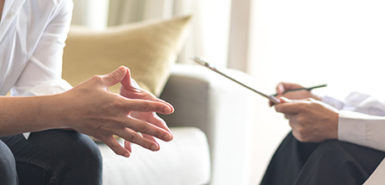
How can individuals with obsessive compulsive disorder differentiate between their helpful actions and their harmful actions?
OCD affects about 1 in 100 adults in the U.S.
One of the categories of obsessions or compulsions experienced by individuals with OCD relates to contamination.
With widespread worries about COVID-19, it’s not difficult to see how this could cause problems.
Individuals who struggle with notions of contamination often have intrusive thoughts about becoming ill, or being exposed to specific diseases.
Their intrusive thoughts are referred to as obsessions.
Some typical examples: Was that surface I touched contaminated? Did I wash my hands long enough? I think the disease is on my clothes. I’ve coughed a few times this morning—I must have a serious disease.
Often, but not always, obsessions are accompanied by compulsions.
This could involve washing hands multiple times a day, not touching certain surfaces, or avoiding certain situations they deem unsafe due to the possibility of infection. The person might even wear gloves when unnecessary.
There are other less obvious types of compulsions that can accompany this type of obsession, such as:
- Compulsively seeking reassurance
- Compulsively and excessively checking news for updates about a virus or disease
- Feeling the need to pray or repeat an action over and over, such as touching items an even number of times or lining things up a certain way
- Trying to counteract any infection
In this COVID-19 pandemic, many people with contamination-type OCD are struggling a great deal, and understandably so.
Several sources are urging people to wash hands frequently, avoid crowds and so on.
People are also constantly seeing updates on the virus, making it harder to control their tendency to compulsively check the news for updates and information.
So the question is: How do individuals differentiate between obsessions and normal concern, and compulsions and safe practice?
The art of list-making
One answer regarding compulsions: Only adhere to the advice of the Centers for Disease Control and Prevention and medical professionals.
If an individual is uncertain about when they should wash their hands, it may be helpful to check the CDC website.
It’s normal to be concerned about coronavirus. It’s normal to want to avoid large crowds right now.
But ruminating on thoughts about these issues is not helpful.
One tactic that can prove helpful: thought-stopping.
When an individual with OCD engages in an obsessive thought, it can be helpful and empowering to label the thought by saying, “That’s just my OCD.”
Then move on to do something to distract the thought.
Daniel Wegner, PhD, a psychology professor at Harvard, researched thought suppression with his classic white bear social experiment.
Dr. Wegner found some helpful tips for those trying to suppress unwanted thoughts:
- Find a distractor that will keep the person occupied
- Engage in meditation and mindfulness
Mental grounding is a good distracting technique.
Count all the green things in the room. Or all the squares. Or all the ceiling tiles.
Counting sounds is another idea.
Some mental grounding techniques can be used in the dark. This includes using lists or letters:
- Make a list of 15 flavors of ice cream.
- Go through the alphabet and list an animal for each letter.
- Pick one letter to focus on—for example, locations that start with C: Chicago, Cairo, Charleston.
If you get stuck at any point in your list-making, give it five seconds and then skip to a new part.
There are endless ideas for creating lists: 15 classic rock bands, 15 stores in the mall, 20 types of plants, 10 different types of trees. Different kinds of fruits and vegetables. Different breeds of dog.
The important thing is to make lists of things that are not going to produce anxiety. That would defeat the purpose.
Don’t make a list of 20 things that need to be done tomorrow, or 15 things that need to be fixed in the house.
Choose things that are relatively easy, but interesting enough to require some focus.
For some people, it’s easy to list 25 different metal bands. For others, it’s easier to list 15 classic writers.
These things help occupy and distract the mind.
Occupy the mind
Avoiding compulsions is key.
Every time a person engages in a compulsion, they are reinforcing and, in a sense, encouraging the obsessions.
It’s normal to have heightened anxiety for the first few minutes of avoiding a compulsion, but this should dissipate over time.
After a while, the urge to engage in compulsions will decrease. When they do arise and the person avoids engaging in them, the anxiety won’t climb as high.
Some compulsions, such as excessive hand-washing, can be kept in check by reading the advice from the CDC.
Avoiding the urge to compulsively check the news can be difficult.
For some, it may be helpful to set aside time every day to do this. For example, from 9-9:30 a.m. and then 7-7:30 p.m., you can check the news. At all other times, avoid it.
Tricks like mindfulness and mental grounding also work for compulsions.
When trying not to engage in a compulsion, it’s helpful to occupy the mind.
Mindfulness is all about being present and in the moment, but not in a way that causes anxiety.
There are many good ways to distract the mind.
Pick up a book or magazine. Binge watch a new show on Netflix. Playing a game. Draw. Color. Listen to music.
Exercise can also be a great distraction, but it has to occupy the mind.
Some people have engrossing hobbies, which can be helpful.
No matter what you choose, just make sure it induces calm—not anxiety.

 /a>
/a>
 /a>
/a>
 /a>
/a>